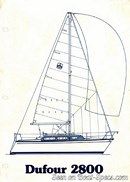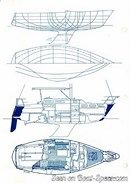Dufour 2800 Shoal draft
Sailboat specifications
The Dufour 2800 is a 27’ (8.23m) cruising sailboat designed by Michel Dufour (France). She was built between 1977 and 1983 by Dufour (France). The Shoal draft version features a shorter keel to grant access to shallow areas.
The Dufour 2800 is as well listed, on Boat-Specs.com, in Deep draft version (see all the versions compared).
The Dufour 2800 is as well listed, on Boat-Specs.com, in Deep draft version (see all the versions compared).
Dufour 2800's main features
- Model
- Dufour 2800
- Version
- Shoal draft
- Hull type
- Monohull
- Category
- Cruising sailboat
- Sailboat builder
- Sailboat designer
- Country
- France
- Construction
- GRP (glass reinforced polyester):
- Hull: Single skin fiberglass polyester
- Deck: Sandwich balsa fiberglass polyester - Number of hulls built
- About 1500
- First built hull
- 1977
- Last built hull
- 1983
- Appendages
- Keel : fin without bulb
- Helm
- Single tiller
- Rudder
- Single spade rudder
- Unsinkable
- No
- Trailerable
- No
- Former French navigation category
- 2
- Standard public price ex. VAT (indicative only)
- N/A €
Dufour 2800's main dimensions
- Overall length
- 27’ 8”8.45 m
- Hull length
- 27’8.23 m
- Waterline length
- 23’ 6”7.15 m
- Beam (width)
- 9’ 4”2.84 m
- Waterline beam (width)
- 8’ 1”2.47 m
- Draft
- 3’ 11”1.2 m
- Mast height from DWL
- 37’ 5”11.4 m
- Fore freeboard
- 3’ 8”1.14 m
- Mid-ship freeboard
- 3’ 2”0.98 m
- Light displacement (MLC)
- 5842 lb2650 kg
- Maximum displacement (MLDC)
- 7253 lb3290 kg
- Ballast weight
- 1984 lb900 kg
- Ballast type
- Cast iron
- French customs tonnage
- 7.11 Tx
Dufour 2800's rig and sails
- Upwind sail area
- 436 ft²40.53 m²
- Downwind sail area
- 737 ft²68.48 m²
- Mainsail area
- 156 ft²14.48 m²
- Genoa area
- 280 ft²26.05 m²
- Jib area
- 184 ft²17.07 m²
- Stormjib area
- 43 ft²4 m²
- Symmetric spinnaker area
- 581 ft²54 m²
- IiFore triangle height (from mast foot to fore stay top attachment)
- 32’ 10”10 m
- JiFore triangle base (from mast foot to bottom of forestay)
- 10’ 11”3.32 m
- PiMainsail hoist measurement (from tack to head)
- 28’ 1”8.55 m
- EiMainsail foot measurement (from tack to clew)
- 9’ 6”2.9 m
- Rigging type
- Sloop Marconi masthead
- Mast configuration
- Deck stepped mast
- Rotating spars
- No
- Number of levels of spreaders
- 1
- Spreaders angle
- 0 °
- Spars construction
- Aluminum spars
- Standing rigging
- 1x19 strand wire continuous
Dufour 2800's performances
- IOR ratingiIOR, or International Offshore Rule, was a measurement rule system used internationally for ocean racing. It allows boats of different sizes and designs to race each other fairly. Therefore, by comparing these values, we can have an indication of the relative speed of 2 boats.
- 20.4
- Upwind sail area to displacementiThe ratio sail area to displacement is obtained by dividing the sail area by the boat's displaced volume to the power two-thirds.
The ratio sail area to displacement can be used to compare the relative sail plan of different sailboats no matter what their size.
Upwind: under 18 the ratio indicates a cruise oriented sailboat with limited performances especially in light wind, while over 25 it indicates a fast sailboat. - 228 ft²/T21.16 m²/T
- Downwind sail area to displacementiThe ratio sail area to displacement is obtained by dividing the sail area by the boat's displaced volume to the power two-thirds.
The ratio sail area to displacement can be used to compare the relative sail plan of different sailboats no matter what their size. - 385 ft²/T35.76 m²/T
- Displacement-length ratio (DLR)iThe Displacement Length Ratio (DLR) is a figure that points out the boat's weight compared to its waterline length. The DLR is obtained by dividing the boat's displacement in tons by the cube of one one-hundredth of the waterline length (in feet).
The DLR can be used to compare the relative mass of different sailboats no matter what their length:
a DLR less than 180 is indicative of a really light sailboat (race boat made for planning), while a DLR greater than 300 is indicative of a heavy cruising sailboat. - 205
- Ballast ratioiThe Ballast ratio is an indicator of stability; it is obtained by dividing the boat's displacement by the mass of the ballast. Since the stability depends also of the hull shapes and the position of the center of gravity, only the boats with similar ballast arrangements and hull shapes should be compared.
The higher the ballast ratio is, the greater is the stability. - 34 %
- Wetted area
- 167 ft²15.53 m²
- Maximum transverse section
- 13 ft²1.21 m²
- Critical hull speediAs a ship moves in the water, it creates standing waves that oppose its movement. This effect increases dramatically the resistance when the boat reaches a speed-length ratio (speed-length ratio is the ratio between the speed in knots and the square root of the waterline length in feet) of about 1.2 (corresponding to a Froude Number of 0.35) . This very sharp rise in resistance, between speed-length ratio of 1.2 to 1.5, is insurmountable for heavy sailboats and so becomes an apparent barrier. This leads to the concept of "hull speed".
The hull speed is obtained by multiplying the square root of the waterline length (in feet) by 1.34. - 6.49 knots
Dufour 2800's auxiliary engine
- Engine(s)
- 1 inboard engine
- Engine(s) power (min./max.)
- 8 HP / 16 HP
- Fuel type
- Diesel
- Fuel tank capacity
- 10.6 gal40 liters
Dufour 2800's accommodations and layout
- Cockpit
- Closed aft cockpit
- Cabin(s)
- 1
- Berth(s)
- 5
- Head(s)
- 1
- Freshwater tank capacity
- 34.3 gal130 liters
- Maximum headroom
- 6’1.84 m
- Head headroom
- 5’ 10”1.78 m
Dufour 2800's saloon
- Maximum headroom
- 5’ 11”1.79 m
- Saloon table length
- 3’ 1”0.95 m
- Saloon table width
- 3’0.9 m
- Saloon width
- 9’ 2”2.8 m
- Berth length
- 6’ 4”1.91 m
- Chart table
- 2’ 10”0.86 m x 2’ 1”0.64 m
- Berth width (head/elbows/knees/feet)
- 1’ 11”0.58 m / 1’ 11”0.58 m / 1’ 11”0.58 m / 1’ 11”0.58 m
Dufour 2800's fore cabin
- Maximum headroom
- 5’ 7”1.72 m
- Berth length
- 6’ 7”2 m
- Berth width (head/elbows/knees/feet)
- 6’ 7”2 m / 4’ 8”1.42 m / 2’ 8”0.83 m / 0’ 10”0.25 m
Dufour 2800's aft cabin
- Berth length
- 6’1.84 m
- Berth width (head/elbows/knees/feet)
- 2’0.6 m / 2’0.6 m / 2’0.6 m / 2’0.6 m






Dufour 2800 interior and accommodations - - 5/5
Picture extracted from the commercial documentation © Dufour
Picture extracted from the commercial documentation © Dufour
Similar sailboats that may interest you:
Sailboats
First built hull
Hull length
1984
25’ 7”7.8 m
1983
27’ 7”8.4 m
1983
28’ 1”8.56 m
1983
28’ 8”8.76 m
1975
26’ 2”8 m
1969
25’ 11”7.9 m
1987
28’ 1”8.58 m
1975
27’ 7”8.4 m
1983
30’ 2”9.2 m
1994
27’ 5”8.35 m
1989
25’ 4”7.7 m
1977
27’8.23 m
1984
29’ 8”9.05 m
1979
24’ 11”7.6 m
1980
30’ 6”9.3 m